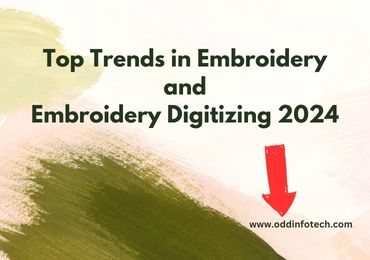Embroidery, a timeless art form, continues to evolve with each passing year, blending traditional techniques with modern innovations. As we step into 2024, the world of embroidery and embroidery digitizing is poised for exciting transformations. Let’s delve into the top trends shaping this vibrant industry.
Introduction to Embroidery Trends
Embroidery has been an integral part of human history for centuries, with its origins tracing back to ancient civilizations such as Egypt, China, and India. Initially used for practical purposes like clothing repair and reinforcement, embroidery gradually evolved into a form of artistic expression, adorning garments, accessories, and household items with intricate designs and motifs.
What is Embroidery?
Embroidery is a handicraft technique that involves decorating fabric using needle and thread. It encompasses a wide range of stitching styles, from basic stitches like running stitch and satin stitch to more complex techniques such as crewelwork and stumpwork. Embroidery can be done by hand or by machine, with each method offering its own set of advantages and creative possibilities.
Evolution of Embroidery
Over the centuries, embroidery has undergone significant transformations, reflecting changes in cultural, social, and technological landscapes. From the elaborate silk embroideries of the Renaissance to the colorful folk embroideries of different cultures, each era has left its mark on this versatile craft. With the advent of industrialization, embroidery saw a shift towards mechanization, paving the way for mass production and commercialization.
Importance of Following Trends in Embroidery
In today’s fast-paced world, staying abreast of the latest trends is essential for embroiderers looking to stand out in a competitive market. Trends in embroidery encompass a wide range of aspects, including design styles, color palettes, techniques, and materials. By embracing current trends while infusing their unique creative vision, embroiderers can create pieces that resonate with contemporary audiences and meet evolving consumer preferences.
Embroidery trends not only influence individual artistic practices but also shape broader industry dynamics, driving demand for specific products, services, and technologies. Whether you’re a seasoned embroiderer or a novice enthusiast, understanding and leveraging embroidery trends can unlock new opportunities for growth, innovation, and artistic expression in this timeless craft.
Emerging Styles and Techniques
Embroidery is experiencing a renaissance in the 21st century, with a wave of fresh styles and techniques captivating artisans and enthusiasts alike. These emerging trends push the boundaries of traditional embroidery, blending innovation with time-honored craftsmanship to create stunning works of art.
Contemporary Embroidery Designs
Contemporary embroidery designs break free from the constraints of convention, embracing bold colors, abstract motifs, and unconventional compositions. From geometric patterns to abstract florals, these designs infuse a modern aesthetic into the age-old craft, appealing to a new generation of embroiderers and consumers. Contemporary embroidery often incorporates elements of minimalism, with clean lines and simplified forms making a striking statement on fabric.
Sustainable Embroidery Practices
As environmental consciousness grows, so does the demand for sustainable embroidery practices. Embroiderers are increasingly turning to eco-friendly materials such as organic cotton, hemp, and bamboo, reducing their carbon footprint and supporting ethical production methods. Additionally, techniques like upcycling and zero-waste embroidery minimize waste and maximize resource efficiency, aligning embroidery with principles of environmental stewardship.
Mixed Media Embroidery Art
Mixed media embroidery art combines traditional stitching with a variety of other mediums, including paint, collage, and even digital elements. This interdisciplinary approach blurs the boundaries between different artistic disciplines, resulting in dynamic and visually captivating pieces. Mixed media embroidery artists experiment with texture, layering, and composition, pushing the limits of what is possible with needle and thread.
Advanced Embroidery Stitching Techniques
Advancements in embroidery stitching techniques empower embroiderers to create intricate and detailed designs with precision and ease. From advanced satin stitches to complex thread painting techniques, these innovations expand the creative repertoire of embroiderers, allowing them to bring their artistic visions to life with unparalleled finesse. With the help of specialized tools and equipment, embroiderers can achieve stunning effects that were once thought impossible.
Digital Revolution: Embroidery Digitizing
In the digital age, embroidery digitizing has emerged as a game-changer, revolutionizing the way designs are created and executed. This transformative technology offers unprecedented precision, flexibility, and efficiency, empowering embroiderers to bring their visions to life with unparalleled accuracy and detail.
Introduction to Embroidery Digitizing
Embroidery digitizing involves the conversion of artwork into digital embroidery files that can be read and interpreted by embroidery machines. This process typically begins with the creation of a digital design using specialized software, where each stitch is meticulously planned and programmed. Once the design is digitized, it can be transferred to an embroidery machine, which translates the digital instructions into physical stitches on fabric.
Cutting-Edge Software and Tools
Embroidery digitizing software has come a long way in recent years, offering a plethora of features and functionalities to streamline the design process. From intuitive user interfaces to advanced editing tools, these software programs empower embroiderers to unleash their creativity and craft intricate designs with ease. Additionally, specialized tools such as auto-digitizing algorithms and stitch simulation features enhance efficiency and accuracy, ensuring flawless results every time.
Customization and Personalization
One of the key benefits of embroidery digitizing is its ability to facilitate customization and personalization on a mass scale. With digital embroidery files, embroiderers can easily modify designs to suit individual preferences, whether it’s adjusting colors, resizing elements, or adding personalized text. This level of flexibility opens up a world of possibilities for creating unique and bespoke embroidered products, from custom apparel and accessories to corporate branding and promotional items.
Advancements in Machine Embroidery Technology
Embroidery machines have also undergone significant advancements, integrating cutting-edge technology to enhance performance and versatility. Modern embroidery machines boast features such as multiple needle positions, automatic thread tension adjustment, and high-speed stitching capabilities, allowing for faster production and superior stitch quality. Additionally, innovations like laser guidance systems and computerized pattern recognition further streamline the embroidery process, ensuring precision and consistency across every stitch.
Influential Color Palettes and Themes
Color palettes and themes play a pivotal role in shaping the aesthetic appeal and emotional impact of embroidered designs. In 2024, several trends are emerging in the realm of embroidery, influencing the choice of colors and motifs embraced by embroiderers worldwide.
Pantone’s Color of the Year Influence
Each year, Pantone selects a “Color of the Year,” which sets the tone for design trends across various industries, including embroidery. For 2024, Pantone’s chosen color exerts a significant influence on the palettes favored by embroiderers, dictating which hues dominate the scene. Whether it’s a vibrant and energizing shade or a calming and soothing tone, embroiderers incorporate Pantone’s Color of the Year into their designs to stay on-trend and resonate with contemporary tastes.
Nature-Inspired Themes
Nature has long served as a boundless source of inspiration for embroidery, with its diverse flora and fauna offering endless possibilities for creative exploration. In 2024, nature-inspired themes continue to captivate embroiderers, with motifs like flowers, birds, and botanical elements adorning fabrics in intricate detail. Whether it’s a whimsical woodland scene or a delicate floral bouquet, embroiderers draw inspiration from the beauty and serenity of the natural world, infusing their designs with a sense of organic elegance.
Retro and Nostalgic Palettes
Nostalgia reigns supreme in embroidery trends, as embroiderers revisit bygone eras and iconic design aesthetics for inspiration. Retro color palettes reminiscent of the 1960s, 70s, and 80s evoke a sense of nostalgia and vintage charm, with bold hues and psychedelic patterns making a comeback in embroidered designs. Whether it’s a retro-inspired floral motif or a geometric pattern straight out of the disco era, embroiderers embrace the nostalgia trend, infusing their creations with a playful and retro-chic vibe.
Cultural and Global Influences
In an increasingly interconnected world, cultural and global influences permeate embroidery trends, introducing diverse color palettes and motifs inspired by different traditions and heritage. From intricate tribal patterns to vibrant folk motifs, embroiderers draw inspiration from a rich tapestry of global cultures, celebrating diversity and inclusivity in their designs. Whether it’s a traditional motif from Asia, Africa, or Latin America, embroiderers pay homage to cultural heritage while infusing their creations with a contemporary twist, resulting in designs that are both timeless and culturally resonant.
Innovative Materials and Textures
Embroidery is not just about thread and fabric; it’s also about exploring new materials and textures to add depth, dimension, and visual interest to designs. In 2024, embroiderers are pushing the boundaries of traditional techniques by incorporating innovative materials and experimenting with unconventional textures.
Sustainable Fabric Choices
With sustainability at the forefront of consumer consciousness, embroiderers are turning to eco-friendly fabric choices to minimize environmental impact. Organic cotton, grown without the use of synthetic pesticides or fertilizers, is a popular option among environmentally conscious embroiderers. Bamboo fabric, derived from the fast-growing bamboo plant, offers a sustainable alternative to conventional cotton, boasting natural antibacterial properties and a luxurious softness. Additionally, hemp fabric, known for its durability and breathability, is gaining popularity among eco-minded embroiderers seeking to reduce their carbon footprint.
Textured Embroidery Techniques
Texture adds visual and tactile interest to embroidered designs, transforming flat surfaces into dynamic works of art. Embroiderers are exploring a variety of textured embroidery techniques to achieve unique and striking effects. Raised embroidery, also known as stumpwork, involves building up layers of padding beneath the stitches to create three-dimensional forms and embellishments. French knots, bullion stitches, and seed stitches are just a few examples of textured stitches that add depth and dimension to designs, creating a rich tapestry of textures that beg to be touched and admired.
Experimental Thread Options
Thread choice plays a crucial role in determining the look and feel of embroidered designs, and embroiderers are increasingly experimenting with unconventional thread options to achieve distinctive effects. Metallic threads, infused with metallic fibers or coated with metallic foil, add a touch of shimmer and shine to designs, perfect for adding accents and embellishments that catch the light. Variegated threads, with their subtle color gradients and transitions, create mesmerizing visual effects, adding depth and movement to embroidered motifs. Additionally, conductive threads, infused with conductive materials like silver or copper, open up new possibilities for incorporating technology into embroidery, allowing for interactive and illuminated designs that blur the line between craft and innovation.
Incorporation of Novel Elements
Innovation knows no bounds in the world of embroidery, as embroiderers experiment with a wide range of novel elements to enhance their designs. Beads, sequins, and pearls add sparkle and glamour to embroidered motifs, elevating them from ordinary to extraordinary. Fabric paints and dyes allow embroiderers to add color and detail to their designs, creating vibrant and expressive works of art. Additionally, unconventional materials such as wire, paper, and even plastic are finding their way into embroidered creations, pushing the boundaries of traditional techniques and challenging perceptions of what embroidery can be.
Influencer and Social Media Impact
In the digital age, social media platforms and influencers wield significant influence over trends and consumer behavior, and the world of embroidery is no exception. Embroidery influencers leverage their online presence to showcase their work, share inspiration, and connect with a global community of fellow enthusiasts, driving innovation and shaping the direction of embroidery trends in 2024.
Rise of Embroidery Influencers
Embroidery influencers, also known as “stitchfluencers,” are individuals who have amassed a sizable following on social media platforms like Instagram, TikTok, and Pinterest by sharing their passion for embroidery. These influencers showcase their latest creations, offer tutorials and tips, and collaborate with brands and fellow artists, positioning themselves as authorities in the world of embroidery. With their engaging content and relatable personalities, embroidery influencers inspire and educate their followers, fueling interest and enthusiasm for the craft.
Social Media Platforms as Creative Hubs
Social media platforms serve as vibrant creative hubs for embroidery enthusiasts, providing a platform for sharing ideas, inspiration, and feedback in real-time. Instagram, with its visually focused interface, is particularly popular among embroiderers, who use the platform to showcase their work through photos and videos. TikTok, with its short-form video format, offers a dynamic and engaging space for embroiderers to share tutorials, time-lapse videos, and behind-the-scenes glimpses of their creative process. Additionally, Pinterest serves as a virtual mood board, allowing embroiderers to curate collections of inspiration and discover new techniques, styles, and trends.
Collaboration and Community Building
Embroidery influencers play a crucial role in fostering collaboration and community building within the embroidery community. Through collaborations with brands, fellow artists, and followers, influencers create opportunities for shared creativity and mutual support, driving innovation and pushing boundaries. Whether it’s a joint embroidery project, a collaborative workshop, or a virtual stitch-along, these initiatives strengthen bonds and forge connections, nurturing a sense of belonging and camaraderie among embroiderers worldwide.
Interactive Workshops and Tutorials
Embroidery influencers harness the power of social media to offer interactive workshops, tutorials, and online courses, providing aspiring embroiderers with the skills and knowledge to embark on their own creative journeys. These educational resources cover a wide range of topics, from basic stitching techniques to advanced embroidery projects, catering to embroiderers of all skill levels and interests. Through live streams, video tutorials, and interactive Q&A sessions, influencers engage with their audience in real-time, fostering a supportive and collaborative learning environment that empowers embroiderers to unleash their creativity and explore new possibilities in the world of embroidery.
Conclusion
Embroidery and embroidery digitizing are vibrant and dynamic fields that continue to evolve and innovate, driven by a passion for creativity and craftsmanship. As we look towards the future, the top trends in embroidery for 2024 promise to inspire and delight enthusiasts of all skill levels, offering new opportunities for artistic expression and exploration.
In the coming year, we can expect to see a continuation of trends such as contemporary designs, sustainable practices, mixed media experimentation, and advanced stitching techniques. These trends reflect a growing appreciation for innovation, sustainability, and diversity within the embroidery community, as embroiderers push the boundaries of tradition and embrace new technologies and materials.
Moreover, the influence of social media and embroidery influencers will continue to shape the landscape of embroidery trends, providing a platform for collaboration, inspiration, and community building. Through interactive workshops, tutorials, and collaborative projects, embroiderers will have the opportunity to connect with like-minded individuals, share knowledge and expertise, and collectively contribute to the vibrant and thriving embroidery community.
As we embark on this journey into the future of embroidery, let us embrace the spirit of creativity, experimentation, and collaboration that defines this timeless craft. Whether you’re a seasoned embroiderer or a novice enthusiast, there’s never been a better time to explore the endless possibilities of embroidery and embroidery digitizing in 2024 and beyond. So grab your needle and thread, unleash your imagination, and let’s embark on this exciting adventure together!
FAQs (Frequently Asked Questions)
Q: Is embroidery digitizing the same as traditional hand embroidery?
- While both involve creating designs with stitches, embroidery digitizing refers to the process of converting digital images into stitch patterns that can be read by embroidery machines, whereas traditional hand embroidery is done manually with a needle and thread.
Q: How can I incorporate sustainable practices into my embroidery projects?
- You can opt for eco-friendly materials such as organic threads and biodegradable fabrics, reduce waste by using upcycled or reclaimed materials, and minimize energy consumption by choosing energy-efficient embroidery machines.
Q: Are virtual embroidery workshops suitable for beginners?
- Yes, virtual embroidery workshops cater to stitchers of all skill levels, including beginners. Many workshops offer introductory classes where you can learn the basics of embroidery techniques and build a solid foundation for your stitching journey.
Q: What are some sustainable fabric choices for embroidery?
- Organic cotton
- Bamboo
- Hemp
Q: How can I incorporate mixed media into my embroidery projects?
- Experiment with fabric scraps, paper, or even metal elements.
- Explore techniques such as appliqué or collage.
Q: Where can I find embroidery tutorials and workshops?
- Online platforms like YouTube and Skillshare offer a plethora of tutorials.
- Local craft stores often host workshops and classes.
Q: What are some popular embroidery digitizing software options?
- Wilcom EmbroideryStudio
- Pulse Embroidery Software
- Hatch Embroidery Software
Q: How can I stay updated on the latest embroidery trends?
- Follow embroidery influencers on social media platforms like Instagram and Pinterest.
- Join online communities and forums dedicated to embroidery enthusiasts.
Are you ready to elevate your embroidery game to the next level?
Look no further! Our blog serves as a hub for the latest trends, techniques, and innovations in the world of embroidery. Whether you’re a seasoned embroiderer or just starting out, our comprehensive guides and informative articles will inspire and guide you on your creative journey.
But why stop there? Visit our website for all your embroidery digitizing needs! Whether you’re looking to convert your designs into digital files or explore the possibilities of machine embroidery, our cutting-edge digitizing services have got you covered. With precision, efficiency, and attention to detail, we’ll help you bring your visions to life like never before.
Do you need an embroidery digitizer? The answer is yes! In today’s fast-paced world, staying ahead of the curve is essential for success. Embrace the digital revolution and unlock a world of limitless possibilities in embroidery. Whether you’re a hobbyist or a business owner, embroidery digitizing offers unparalleled precision, flexibility, and customization options that will set you apart from the competition.
So what are you waiting for? Dive into the fascinating world of embroidery trends, techniques, and digitizing services today! Join our community of passionate embroiderers and let’s embark on this exciting journey together. Visit our website now and unleash your creativity like never before!




Leave A Comment